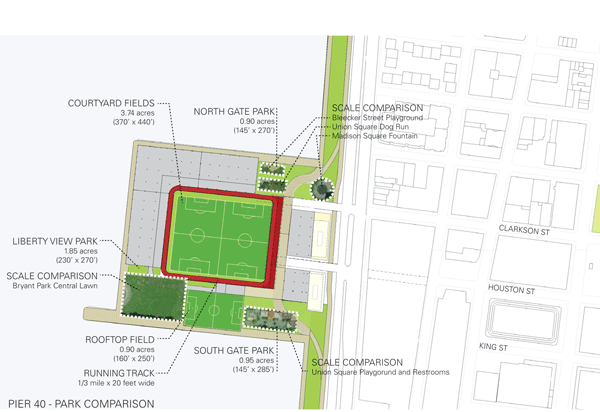Several months ago developer Douglas Durst offered an alternative proposal for Pier 40.
Now, based on a recent professional engineering study of the aging pier’s thousands of metal support piles that Durst commissioned, he says the piles can be preserved in their current condition for as little as $30 million.
In both cases, Durst seems to be at odds with the Hudson River Park Trust, the state-city authority that is building and operating the 5-mile-long park, which includes Pier 40, at West Houston St., as its largest, revenue-generating “commercial node.”
As it so happens, Durst is also chairperson of the Friends of Hudson River Park, which was formerly the park’s watchdog group — filing lawsuits, if needed, to get unwanted municipal or other uses out of the park. Today, the Friends are the park’s main private fundraising group, and its executive director, A.J. Pietrantone, has been a leader of the effort to form a neighborhood improvement district, or NID, to raise badly need funds for the cash-strapped park, which is intended to be financially self-sustaining.
Meanwhile, the Trust, under the leadership of its president, Madelyn Wils, and chairperson, Diana Taylor, for the past year, has been saying that the Hudson River Park Act of 1998 needs to be opened up, to allow more uses, particularly on Pier 40. The uses currently allowed under the legislation — such as big-box retail outlets or destination entertainment — are exactly what most in the surrounding community — and the local youth sports leagues — have said they don’t want, fearing the impact these uses would bring.
The youth leagues want two things: above all, to keep the pier afloat, and, second, to ensure that they can keep using the pier’s courtyard sports field without any interruption that would be caused by a redevelopment project.
So, what are we to make of Durst’s alternative Pier 40 plan, as well as his new lowballing of the piles repair cost estimate?
Durst’s Pier 40 plan is an adaptive reuse that would consolidate the pier’s parking, opening up space for a high-tech campus — essentially, commercial office space. He has said he won’t build this proposal, if it wins approval, but is putting it out there as a helpful idea. Meanwhile, among the uses the Trust says are in the mix of things it wants to add to the park act is residential housing at or on Pier 40. Durst, an experienced developer, says residential housing won’t work on the pier.
The new piles study and cost estimate is very interesting. If it’s true that Pier 40’s piles can be preserved for just $30 million, as opposed to the $80 million that the Trust claims, it really changes the playing field (pun intended). Is a project as expensive and large — and heavy, requiring additional reinforcement of the piles, and thus more money — as residential needed if the pier can be stabilized for so much less money?
It’s unusual to see the leader of the park’s former main advocacy group so at odds with the Trust’s leadership, but again, Durst doesn’t see it that way. It’s not a “mutiny on the waterfront,” he says, claiming he’s just trying to help. Indeed, as an experienced, reputable developer, he may very well be helping us find a solution.
Many of these issues would have been broached at a Pier 40 forum that was postponed by Superstorm Sandy. That forum will now be happening early in the new year, and it will be an excellent opportunity to brainstorm on a solution to the park’s biggest challenge.
Durst and the Trust agree that if the pier’s piles are fixed starting now, it will be cheaper. But the question is — who would pay that, say, $30 million? If questions like that can be answered at the forum, we’ll be a long way toward solving the Pier 40 predicament. Durst is putting out good information — but we also need some answers. If all parties can work together, we may find some.


















